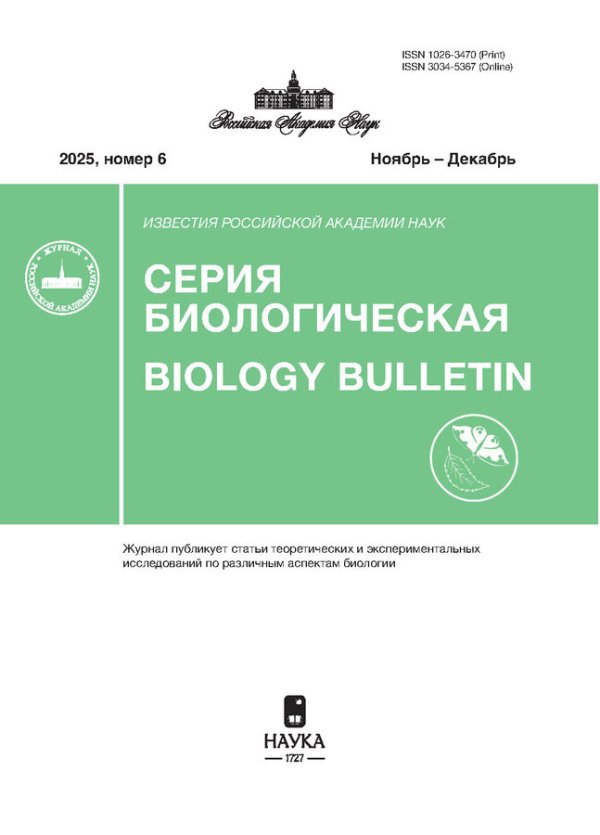Shedding of a Thick Layer of Glycocalyx in Cystacanth of the Acanthocephalan Acanthocephalus tenuirostris (Achmerov et Dombrowskaja – Achmerova, 1941)
- Authors: Davydenko T.V.1, Nikishin V.P.1
-
Affiliations:
- Institute of Biological Problems of the North
- Issue: No 6 (2023)
- Pages: 716-720
- Section: КРАТКИЕ СООБЩЕНИЯ
- URL: https://journals.rcsi.science/1026-3470/article/view/231722
- DOI: https://doi.org/10.31857/S1026347023600103
- EDN: https://elibrary.ru/EUUVQS
- ID: 231722
Cite item
Full Text
Abstract
An electron microscopic study of the teguments of the late acanthella and the cystacanth acanthocephalan Acanthocephalus tenuirostris obtained in the experiment was carried out. The late acanthella is characterized by a bilayer cyst and signs of intense secretion in the surface part of the tegument. A cystacanth is characterized by a cyst and a thick layer of glycocalyx on the surface of the tegument, which are closely adjacent to each other along their entire length. During the preparation of some cystacanths, the cyst received mechanical damage; in these cystacanths, shedding of a thick layer of glycocalyx and associated cyst was observed.
About the authors
T. V. Davydenko
Institute of Biological Problems of the North
Author for correspondence.
Email: sesha17@mail.ru
Russia, 685000, Magadan, Portovaya str., 18
V. P. Nikishin
Institute of Biological Problems of the North
Email: sesha17@mail.ru
Russia, 685000, Magadan, Portovaya str., 18
References
- Атрашкевич Г.И., Орловская О.М., Регель К.В., Михайлова Е.И., Поспехов В.В. Паразитические черви животных Тауйской губы // Биологическое разнообразие Тауйской губы Охотского моря. Отв. ред. Черешнев И.А. Владивосток: Дальнаука. 2005. С. 175–251.
- Никишин В.П. Цитоморфология скребней. М: ГЕОС, 2004. 234 с.
- Никишин В.П. Модификации гликокаликса скребней // Изв. РАН. Сер. биол. 2018. № 1. С. 42. https://doi.org/10.7868/S000233291801006X
- Скоробрехова Е.М., Никишин В.П. Феномен сбрасывания слоя гликокаликса у скребня Corynosoma strumosum (Rudolphi, 1802) Lühe, 1904 (Acanthocephala: Polymorphidae) в паратенических хозяевах в природе и эксперименте // Биология моря. 2023. Т. 49. № 1. С. 8–16.
- Шульц Р.С., Гвоздев Е.В. Основы общей гельминтологии. Том I. Морфология, систематика, филогения гельминтов. М.: Наука, 1970. 492 с.
- Da’dara A.A., Krautz-Peterson G. New insights into the reaction of Schistosoma mansoni cercaria to the human complement system // Parasitology Research. 2014. V. 113. P. 3685–3696. https://doi.org/10.1007/s00436-014-4033-3
- Horak P., Kovar L., Kolarova L., Nebesarova J. Cercaria–schistosomulum surface transformation of Trichobilharzia szidati and its putative immunological impact // Parasitology. 1998. V. 116. P. 139–147. https://doi.org/10.1017/s0031182097002059
- Lammas D.A., Duffus W.P.H. The shedding of the outer glycocalyx of juvenile Fasciola hepatica // Veterinary Parasitol. 1983. V. 12. № 2. P. 165–178. https://doi.org/10.1016/0304-4017(83)90005-5
- Lumsden R.D. Ultrastructure of the metacercarial cyst of Asococtyle chandlery Lumsden, (1963) (Trematoda: Heterophyidae). Priceedings of the Helminthological Society of Washington. 1968. V. 35. P. 212–219
- Lumsden R.D. Surface ultrastructure and cytochemistry of parasitic helminths // Exp. Parasitol. 1975. V. 37. № 2. P. 267. https://doi.org/10.1016/0014-4894(75)90078-8
- Nikishin V.P. Formation of the capsule around Filicollis anatis in its intermediate host // J. Parasitol. 1992. V. 78. № 1. P. 127.
- Řimnáčová J., Mikeš L., Turjanicová L., Bulantová J. Changes in surface glycosylation and glycocalyx shedding in Trichobilharzia regenti (Schistosomatidae) during the transformation of cercaria to schistosomulum// PLoS ONE 12 (3): e0173217. 2017. https://doi.org/10.1371/journal.pone.0173217
- Samuelson J.C., Caulfield J.P. Loss of covalently labeled glycoproteins and glycolipids from the schistosomula of Schistosoma mansoni // J. Cell Biol. 1982. V. 94. № 2. P. 363–369. https://doi.org/10.1083/jcb.94.2.363
- Schmidt G.D. Development and life cycles. In: Biology of the Acanthocephala. Edited by D.W.T. Crompton, B.B. Nickol. Cambridge University Press. 1985. P. 273– 305.
- Skorobrechova E.M., Nikishin V.P. Structure of capsule surrounding acanthocephalans Corynosoma strumosum in paratenic hosts of three species // Parasitology Research. 2011. V. 108. P. 467–475. https://doi.org/10.1007/s00436-010-2088-3
- Zambrano-Vila S., Rosales-Borjas D., Carrero J.C., Ortiz-Ortiz L. How protozoan parasites evade the immune response // Trends in Parasitol. V. 18. № 6. P. 272–278. https://doi.org/10.1016/S1471-4922(02)02289-4
Supplementary files











